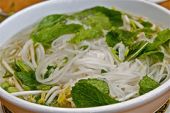Spa Cuisine Of New Asia
 A familiar greeting often heard in Asia, ‘Have you eaten yet?’ is used in the same manner as ‘How are you today?’. This charming tradition reflects the importance that is placed on a good meal, broadly defined as a meal that contributes to your physical and mental well-being. The nutritional value of a meal is considered as important as the experience of having it – the Vietnamese, for instance view mealtimes as a time of bonding with family or friends. In the culinary world, Asia is broadly divided into three areas: Northeast (India, Pakistan, Sri Lanka and Burma), Southeast (Thailand, Laos, Cambodia, Vietnam, Indonesia, Malaysia, Singapore and Brunei) and Southwest (China, Korea and Japan). Some ingredients and dishes are common to all – spices are invariably used, curries are served, and rice and noodles are generally regarded as staples. Yet the cuisine in each area remains distinct in that its use of ingredients and preparation methods differ. For instance, curries in Northeast and Southeast Asia are generally coconut-milk-based while those from Southwest are yogurt based. In New Asian cuisine, Asian ingredients and dishes are used and prepared in ways commonly regarded as Western. Ingredients from different cuisines are prepared alongside each other and the influence of different countries’ cuisines can be found within a meal. The following recipes show evidence of Japanese, Indian and Thai influences. The tuna tartare with wasabi dressing reflects Japanese-style cooking; mint chutney is a common accompaniment to Indian meals; and the main course, with its use of lemon grass, galangal and coriander is clearly Thai-influenced.
A familiar greeting often heard in Asia, ‘Have you eaten yet?’ is used in the same manner as ‘How are you today?’. This charming tradition reflects the importance that is placed on a good meal, broadly defined as a meal that contributes to your physical and mental well-being. The nutritional value of a meal is considered as important as the experience of having it – the Vietnamese, for instance view mealtimes as a time of bonding with family or friends. In the culinary world, Asia is broadly divided into three areas: Northeast (India, Pakistan, Sri Lanka and Burma), Southeast (Thailand, Laos, Cambodia, Vietnam, Indonesia, Malaysia, Singapore and Brunei) and Southwest (China, Korea and Japan). Some ingredients and dishes are common to all – spices are invariably used, curries are served, and rice and noodles are generally regarded as staples. Yet the cuisine in each area remains distinct in that its use of ingredients and preparation methods differ. For instance, curries in Northeast and Southeast Asia are generally coconut-milk-based while those from Southwest are yogurt based. In New Asian cuisine, Asian ingredients and dishes are used and prepared in ways commonly regarded as Western. Ingredients from different cuisines are prepared alongside each other and the influence of different countries’ cuisines can be found within a meal. The following recipes show evidence of Japanese, Indian and Thai influences. The tuna tartare with wasabi dressing reflects Japanese-style cooking; mint chutney is a common accompaniment to Indian meals; and the main course, with its use of lemon grass, galangal and coriander is clearly Thai-influenced.